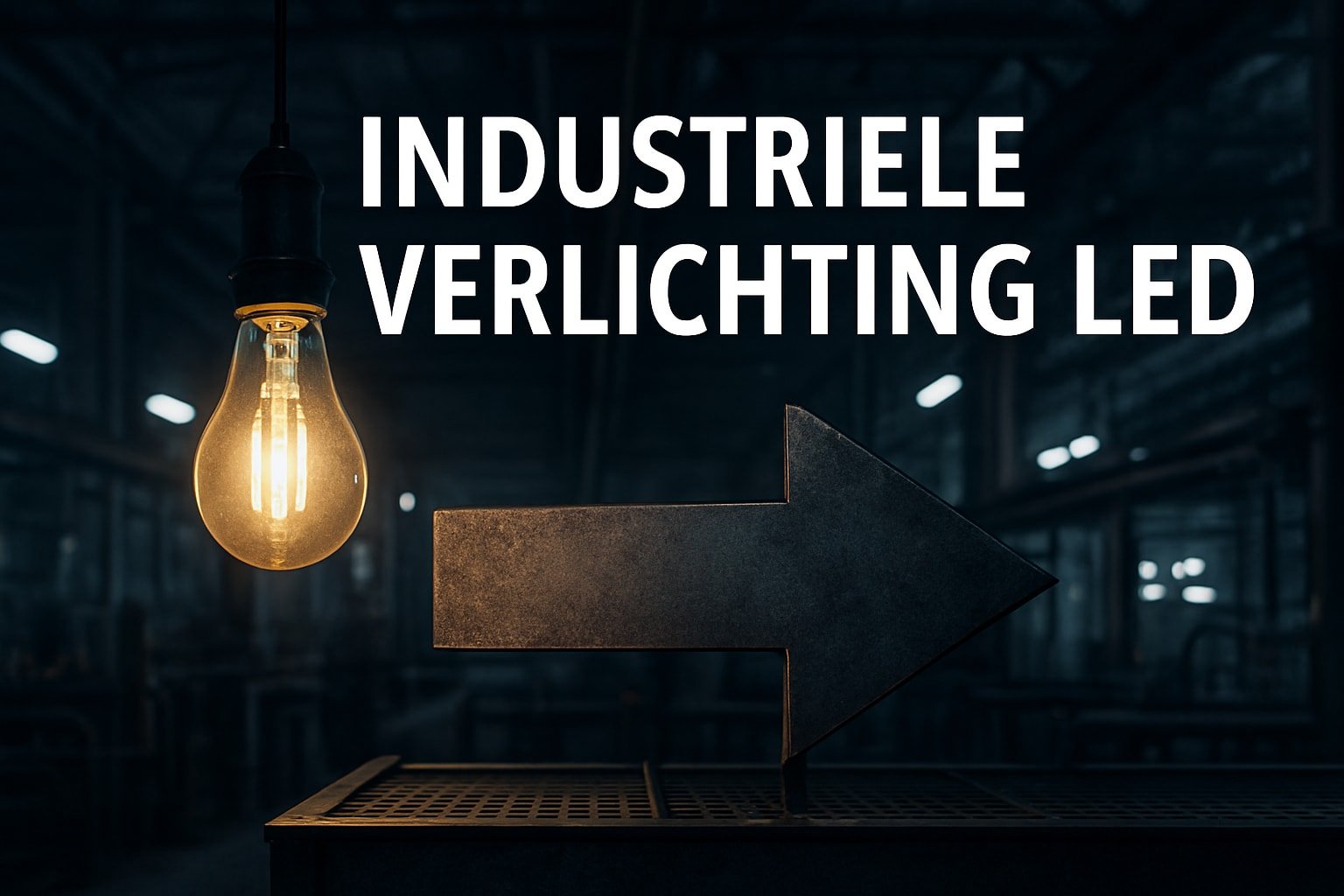Industrial lighting LED faces major challenges in 2025 due to rising energy costs, stricter regulations and increased safety requirements. Smart LED solutions are now indispensable for companies looking to save, become more sustainable and improve the working environment.
This guide helps you choose, implement and optimize industrial lighting LED with smart technology. You'll discover the latest trends, selection criteria, innovative applications and a clear roadmap for success. Follow this guide and take the step towards an efficient, safe and future-proof industry.
The latest trends and benefits of industrial LED lighting
Industrial companies face major challenges around energy, sustainability and safety in 2025. The switch to industrial lighting LED is no longer just a choice for energy savings, but a strategic necessity. Thanks to smart technologies and innovative luminaires, LED lighting is evolving into an integral part of a future-proof industry.
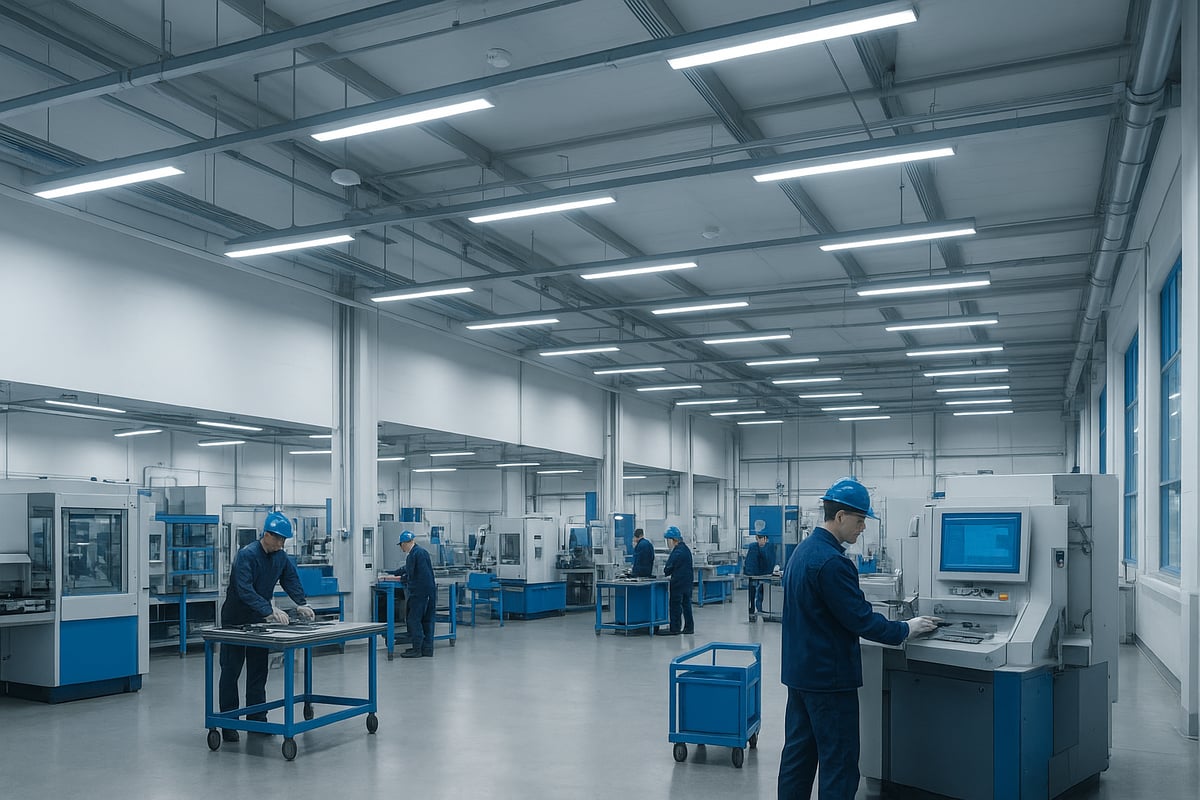
Energy efficiency and cost savings
The impact of industrial lighting LED on energy consumption is enormous. Companies save up to 70 percent on their lighting costs compared to conventional fluorescent systems. With the mandatory phasing out of fluorescent lighting, modernization becomes essential. Smart LED systems with sensors and light management automatically adjust consumption according to occupancy and daylight.
An average LED investment pays for itself in less than three years. This is due to the combination of lower energy costs and minimal maintenance. LED fixtures last much longer and are less prone to malfunctions. In addition, companies benefit from subsidies and tax breaks for sustainable investments. Want to know more about the latest solutions? Check out the possibilities for industrial lighting solutions.
Improved safety and productivity
Another important benefit of industrial lighting led is its positive impact on safety and productivity. Flicker-free light prevents fatigue and increases concentration, leading to fewer errors on the shop floor. Constant light output ensures optimal visibility, even in complex production tasks.
Smart LED systems easily integrate emergency lighting and monitoring. This ensures safety even in the event of power failure or calamities. In sectors such as the food industry, these systems effortlessly meet strict HACCP, IFS and BRC standards. This not only reinforces safety, but also the quality of the production process.
Sustainability and environmental benefits
With industrial lighting LED, a company takes a big step toward sustainability. LED luminaires use less energy, which leads directly to lower carbon emissions. In addition, the lifespan of LED is much longer, resulting in less frequent replacement and less waste.
European production and reliable certifications make the difference in quality and sustainability. As a result, companies can count on luminaires that meet the strictest environmental standards. This contributes to a responsible and future-oriented policy within the industry.
Flexibility and adaptability
The flexibility of industrial lighting LED is one of its greatest strengths. Modern LED systems offer adjustable color temperatures and light intensities per zone or task. This ensures perfect adaptation to different work processes and conditions.
LED luminaires are also suitable for extreme environments, such as high temperatures, humid areas, dust or even explosion hazards. ATEX-certified LED solutions have been developed especially for this purpose. This keeps the lighting reliable regardless of the challenges within the production process.
Key selection criteria for industrial LED lighting in 2025
Choosing the right industrial lighting LED for a modern industrial environment requires a structured approach. In 2025, not only performance and energy efficiency play a role, but also robustness, legislation and smart integration. Below we discuss the key selection criteria that will help you achieve a future-proof solution.
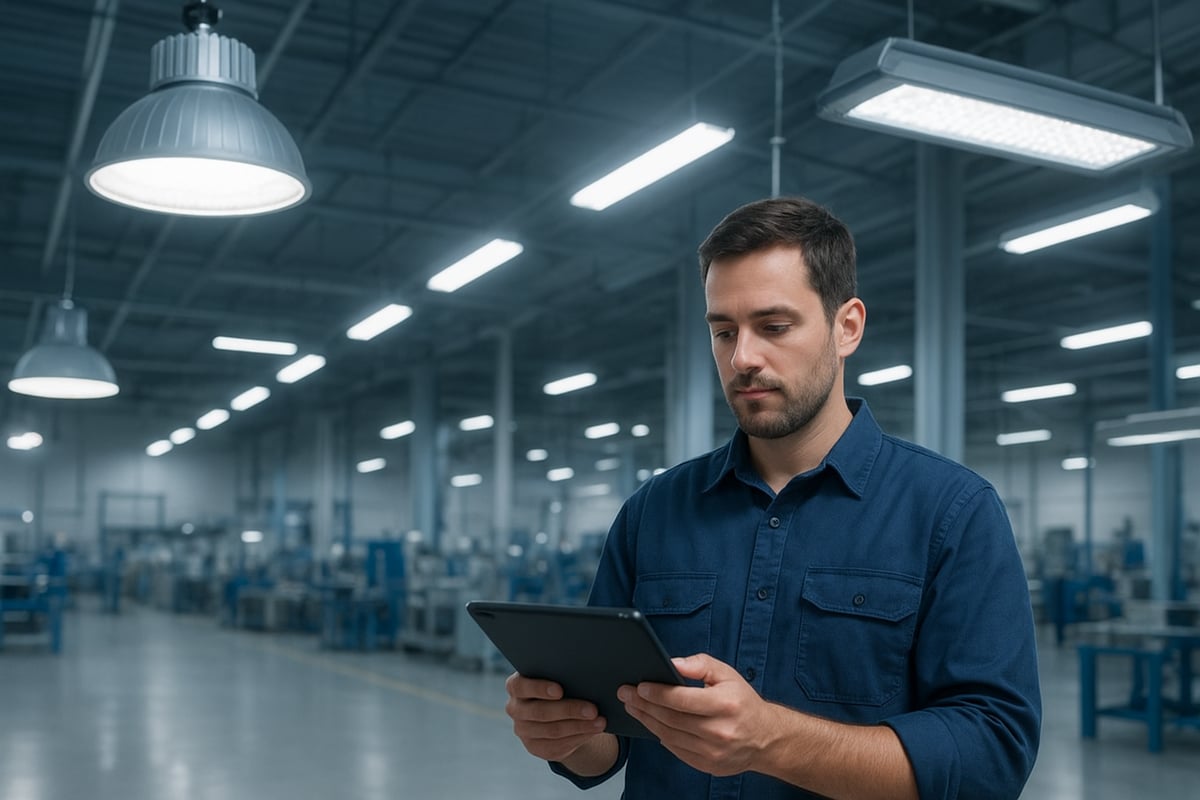
Light quality and performance
The foundation of any industrial lighting LED is light quality. Lumen maintenance (LB value) ensures that luminaires continue to provide adequate light over their lifetime. A high LB value means less rapid light loss, which directly impacts ROI.
Color rendering index (CRI) is crucial for color-critical processes, such as quality control or assembly. The higher the CRI, the more natural colors are rendered. Flicker-free, uniform light prevents fatigue and increases employee comfort and safety.
When selecting, always pay attention to the performance specifications tailored to the work processes and the environment in which the industrial lighting led will be used. A good lighting plan ensures optimal results and satisfied employees.
Robustness and resistance
Industrial environments place high demands on fixtures. The IP rating indicates whether a luminaire can withstand dust and moisture. In areas with a lot of shock, vibration or regular high-pressure cleaning, impact resistance is essential.
In addition, chemical resistance may be necessary in production environments where aggressive substances are handled. Think of food production or chemical industry. The right industrial lighting LED meets all of these requirements, keeping breakdowns and failures to a minimum.
Choosing robust fixtures extends the service life and contributes to a reliable production process. This gives peace of mind and reduces unexpected maintenance costs.
Certification and regulations
Meeting certifications is indispensable with industrial lighting LED. Think ATEX for hazardous areas, HACCP and IFS/BRC for food safety, and CE marking for European conformity. Legislation is changing rapidly, especially now that the phasing out of traditional lighting (such as fluorescent) is in full swing.
Future-proofing requires that your installation meet not only current but also upcoming requirements. For current information on regulations and specific certifications, it is advisable to visit this Legislation surrounding LED lighting consulting.
Always be sure to work with a supplier that is up to date, so that your industrial lighting LED passes audits and inspections without a hitch.
Total cost of ownership (TCO).
It's not just the purchase price that counts, but more importantly, the total cost over the lifetime. With industrial lighting led, you look at maintenance intervals, energy consumption, parts availability and the possibility of smart monitoring.
Low TCO means lower operating costs and fewer unexpected expenses. By choosing long-life systems with simple maintenance procedures, you get maximum benefit from your investment.
Understanding TCO helps compare different vendors and fixtures. This enables an informed choice that aligns with your company's long-term strategy.
Lighting management and smart integration
The future of industrial lighting LED lies in smart light management systems. Compatibility with systems such as DALI or LiveLink enables automatic dimming, daylight control and presence detection.
Linking with building management systems is also becoming increasingly important, bringing lighting, security and climate control together in one central platform. This offers flexibility and scalability, allowing you to easily respond to changing production processes or growth.
By investing in smart integration, you are ready for the next step in digitalization and Industry 4.0, with an industrial lighting LED solution that grows with your ambitions.
Smart applications and innovations: LED lighting as part of Industry 4.0
The rise of Industry 4.0 is changing the way companies deal with industrial lighting LED. Digitalization and automation require lighting solutions that are not only energy efficient, but also smart, flexible and future-proof. Modern LED systems respond to this by combining data, sensors and control software. The result: lighting that actively contributes to efficiency, safety and sustainability in any industrial environment.
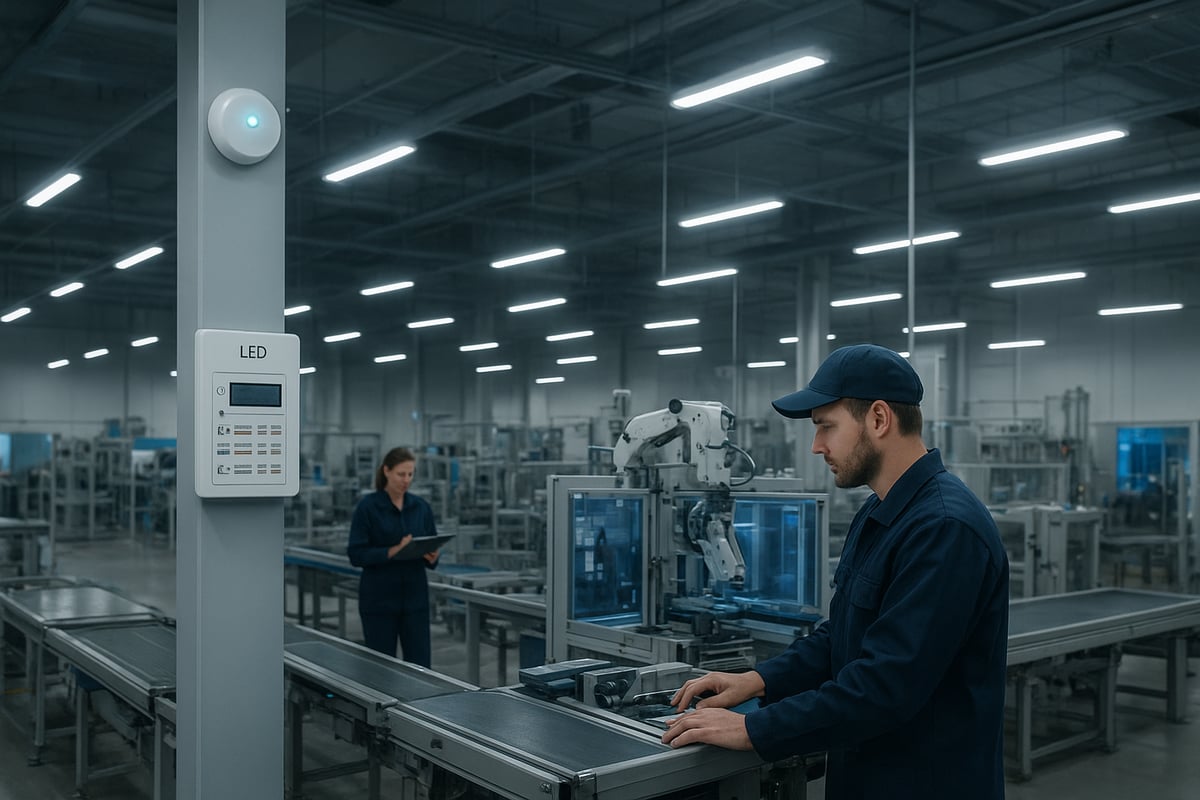
Light management systems
Light management systems are at the heart of smart industrial lighting LED. With central and decentralized control, often via sensors and IoT, consumption can be precisely tuned to requirements. Consider systems such as LiveLink or DALI that monitor and automatically optimize energy consumption in real time.
These systems ensure that light is lit only where it is needed. This prevents unnecessary energy consumption and keeps light quality high at all times. Data analysis allows companies to recognize trends and continuously adjust the lighting plan for maximum efficiency.
Integration with other systems
The strength of industrial lighting LED lies in its seamless integration with other building systems. Lighting is linked to climate control, security and production processes. This creates a fully automated and connected work environment.
Data from the lighting system are used for preventive maintenance and to further optimize processes. In smart factories, lighting is a full part of the digital ecosystem. Want to know more? Then read Industry 4.0 meets lighting: smart LED technology for halls and warehouses.
Adaptive and predictive lighting
One of the biggest innovations within industrial lighting LED is adaptive and predictive lighting. The system automatically adjusts based on presence, daylight and the production cycle. In a warehouse, for example, the lighting turns on only when motion is detected.
This not only saves energy, but also increases safety and comfort for employees. The lighting responds instantly to changing conditions, leading to an optimal working environment at any time of day.
Security and compliance through smart technology
Smart industrial lighting LED contributes directly to safety and regulatory compliance. Remote monitoring allows instant notification of emergency lighting and malfunctions. Administrators automatically receive notifications in case of anomalies or maintenance needs.
This technology integrates seamlessly with existing safety protocols. As a result, the workplace always remains safe and the company easily meets the strictest standards.
Sustainability and circularity
Sustainability is at the heart of the latest generation of industrial lighting LED. Modular luminaires make upgrading or recycling easy, further extending service life. Data-driven optimization minimizes energy consumption.
Companies benefit from lower operating costs and a reduced carbon footprint. This circular approach not only supports environmental goals, but also offers long-term financial benefits.
Five steps to a future-proof LED lighting plan for industry
A future-proof lighting plan is essential for any industrial company that wants to meet the requirements of 2025. With industrial lighting LED, you take a big step toward energy savings, safety and flexibility. But how do you approach such a process in a structured way? Below you will find a clear five-step plan that guides you from analysis to sustainable optimization. This is how to get the most out of smart LED technology for your business environment.
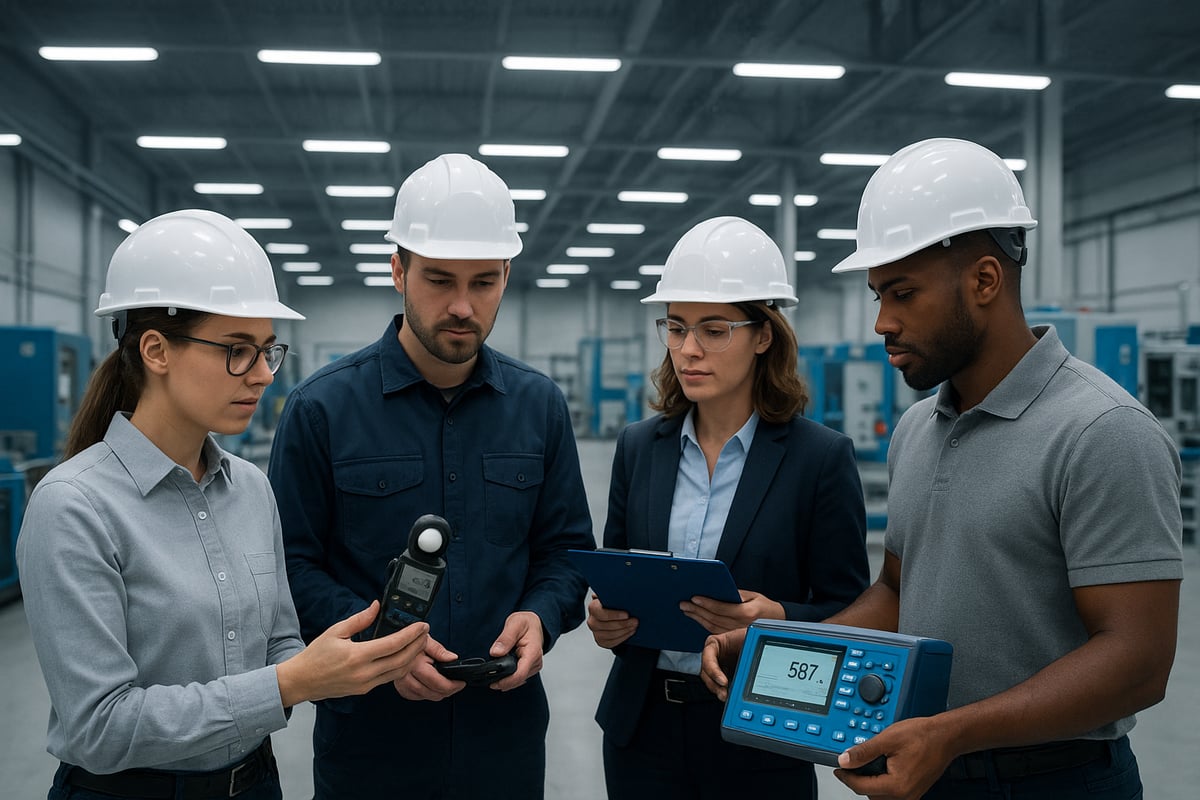
Step 1: Analysis of current situation and requirements
The first step toward an optimal lighting plan begins with a thorough analysis of the existing situation. Inventory the current industrial lighting LED, energy consumption and fixtures used.
Together with a specialist, map out the following points:
- Quality and uniformity of light
- Safety issues and bottlenecks in the workplace.
- Maintenance requirements and failure frequency
- Specific requirements such as ATEX, food safety or temperature zones
A site visit and intake interview are essential to get business processes and requirements in focus. This way you discover where improvements are needed and what results are achievable with industrial lighting LED. This step forms the basis for a customized solution that really fits the business.
Step 2: Design a thoughtful lighting plan
The analysis is followed by the design of a customized lighting plan. Here light calculations are performed per zone, taking into account the tasks and applicable standards. The right choice of luminaires and light management systems determines the success of your industrial lighting LED.
Key points of interest:
- Selection of fixtures for performance, robustness and resistance
- Visualization of the light image with simulations
- Application of smart controls, such as daylight control and presence detection
Want to learn more about the possibilities of business LED solutions? Check out the extensive information on LED lighting for businesses for inspiration and practical examples. Through thoughtful design, you avoid over- or under-exposure and optimize energy consumption.
Step 3: Quote and payback calculation
A clear lighting plan is followed by a transparent quotation. This will provide insight into all costs: from purchase and installation to maintenance. An important part of industrial lighting LED is the calculation of the payback period.
A good quotation includes:
- Detailed cost breakdown
- Estimation of energy savings (often up to 70 percent)
- Calculation of ROI and total lifetime savings
- Information on grant opportunities and tax benefits
A realistic payback period (usually within three years) makes investing in industrial lighting LED extra attractive. With these insights, you can make informed decisions and substantiate the business case internally.
Step 4: Professional installation and integration
Implementation requires craftsmanship. Professional installation of industrial lighting LED is always done according to the highest safety standards. Here, the new lighting is seamlessly integrated with existing infrastructure and systems.
The approach consists of:
- Assembly and wiring of fixtures without disruption of production processes
- Integration of light management systems, such as sensors or central control
- Linking to building management systems or other automation
A structured approach minimizes downtime. The installer ensures that everything functions as designed, so you immediately enjoy the benefits of industrial lighting led. The operation of smart systems is also tested and validated.
Step 5: Completion, monitoring and aftercare
After installation, careful handover follows. The system is tested, adjusted and handed over to the responsible employees. Training is important for optimal use of the industrial lighting LED.
Essentials of this phase:
- Facility management instruction for operation and basic maintenance
- Remote monitoring via energy and performance dashboards
- Preparation of a maintenance plan with periodic checks
Smart monitoring allows you to identify failures early and take immediate action. This prevents failure and extends the life of the installation considerably. By choosing a future-proof maintenance concept, your industrial lighting LED always remains up-to-date and ready for new developments.
Maintenance, monitoring and optimization of industrial LED lighting
A good maintenance plan and smart monitoring are indispensable for modern industrial lighting LED. Through technological innovations, companies can prevent failures, control costs and continue to meet the most stringent requirements. In this section, we explain how maintenance, monitoring and optimization contribute to a future-proof lighting system.
Preventive and predictive maintenance
Preventive and predictive maintenance is essential for industrial lighting LED. By using smart systems, defects and wear are detected in a timely manner. This prevents unexpected failure and minimizes downtime in the production process.
- Automatic fault reports via sensors
- Maintenance planning based on usage data
- Fewer unexpected costs through timely intervention
This approach extends the life of fixtures and contributes to a safe working environment. Want to know more about the latest smart applications? View Smart LED lighting applications For practical examples within the industry.
Data analysis and optimization
Data analytics is at the heart of optimization in industrial lighting LED. Modern systems provide real-time insight into energy consumption and performance through clear dashboards. This allows settings to be adjusted based on actual usage patterns.
For example, companies dim lights during off-peak hours or adjust light intensity by zone. This leads to:
- Direct energy savings
- Higher efficiency of the lighting system
- Quick feedback for continuous improvement
Smart data analysis allows companies to structurally optimize their processes and respond to changing needs.
Cost control and sustainability
Cost control is a key benefit of industrial lighting LED. Predictable maintenance reduces unexpected expenses. Timely replacement of components prevents costly repairs and extends the overall life of the system.
In addition, circular management, such as recycling or upgrading fixtures, contributes to sustainability. This supports companies in achieving environmental goals and minimizing waste streams.
An overview of the benefits:
| Aspect | Result |
|---|---|
| Maintenance | Less unexpected costs |
| Lifetime | Extended by timely maintenance |
| Sustainability | Circular management and less waste |
Compliance and reporting
For industrial lighting LED, compliance with laws and regulations is crucial. Smart systems offer automatic logging and reporting, making audits for certification (such as HACCP or ATEX) easier.
Automatic reports are also useful for grant applications or preparing sustainability reports. This keeps your company always prepared for audits and external requirements.
- Automatic recording of maintenance and malfunctions
- Easy export of reports
- Instant insight into compliance status
Future-proofing
Future-proofing means that industrial lighting LED is easy to expand or upgrade. Modular design and integration with new technologies, such as battery storage or solar power, keep companies flexible.
With smart monitoring, the system is prepared for Industry 5.0 and further digitalization. Want to know more about how smart lighting makes your business future-proof? Read the article Smart industrial LED lighting optimizes the operation of your business For profound insights.
Now that you know what impact smart LED lighting can have on your business-from lower energy costs to a safer and more comfortable work environment-it makes sense to look at how to apply it concretely. You don't have to figure everything out by yourself; we like to actively think along with you about the best solution for your situation. Would you like immediate insight into savings, light quality and future-proofing? We are happy to offer you personal advice and a no-obligation analysis, tailored to your business processes and goals. Take the step towards a smarter lighting future today and Schedule a consultation.
